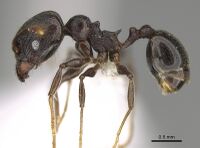Pheidole probolonotum
| Pheidole probolonotum | |
|---|---|

| |
| Scientific classification | |
| Kingdom: | Animalia |
| Phylum: | Arthropoda |
| Class: | Insecta |
| Order: | Hymenoptera |
| Family: | Formicidae |
| Subfamily: | Myrmicinae |
| Tribe: | Attini |
| Genus: | Pheidole |
| Species: | P. probolonotum |
| Binomial name | |
| Pheidole probolonotum Longino, 2019 | |
This species occurs in lowland rainforest. Workers recruit to ground baits and occur in Winkler samples of sifted litter and rotten wood. A nest was discovered in a vertical clay bank in forest. The entrance was an irregular opening, leading to shallow chambers. So far this species is known only from Los Tuxtlas Biological Station.
Identification
Minor: face partially smooth and shining, with discrete patches of faint foveolation scattered over surface; head weakly emarginate behind; promesonotal groove strongly impressed, mesonotum strongly produced, angulate; pronotum smooth and shiny; katepisternum foveolate; propodeal spines about two thirds length of posterior face of propodeum; gaster smooth and shining; pronotum with 0-2 pairs short stiff erect setae; tibiae lack erect setae; gaster with very sparse, fully appressed short pubescence, 0-few longer erect setae; color dark brown.
Major: inner hypostomal teeth widely spaced, acicular; scape base terete; face foveolate throughout, overlain with reticulate rugulae; mesonotum strongly produced; propodeal spines about two thirds length of posterior face of propodeum; gastral dorsum smooth and shiny; pilosity pattern similar to worker, with dorsal surfaces nearly devoid of erect setae.
Measurements, minor worker: HW 0.60, HL 0.67, SL 0.79, EL 0.16, WL 0.88, PSL 0.10, PTW 0.14, PPW 0.21, CI 91, SI 130, PSLI 16, PPI 148 (n=1).
Measurements, major worker: HW 0.93, HL 0.99, SL 0.73, EL 0.18, WL 0.95, PSL 0.12, PTW 0.21, PPW 0.33, CI 94, SI 78, PSLI 13, PPI 154 (n=1).
This species is a version of Pheidole plebecula. Pheidole plebecula is highly geographically variable and P. probolonotum is within the global range of variation of P. plebecula. However, it is sympatric with a regional form of P. plebecula. Compared to the regional form, the dorsal pilosity is reduced and the face of the minor worker has a mix of smooth and foveolate sculpture (smooth in the regional form of P. plebecula).
Distribution
Latitudinal Distribution Pattern
Latitudinal Range: 18.58461° to 18.58461°.
| North Temperate |
North Subtropical |
Tropical | South Subtropical |
South Temperate |
- Source: AntMaps
Distribution based on Regional Taxon Lists
Neotropical Region: Mexico (type locality).
Distribution based on AntMaps
Distribution based on AntWeb specimens
Check data from AntWeb
Countries Occupied
| Number of countries occupied by this species based on AntWiki Regional Taxon Lists. In general, fewer countries occupied indicates a narrower range, while more countries indicates a more widespread species. |

|
Estimated Abundance
| Relative abundance based on number of AntMaps records per species (this species within the purple bar). Fewer records (to the left) indicates a less abundant/encountered species while more records (to the right) indicates more abundant/encountered species. |

|
Biology
Castes
Worker
Minor
Images from AntWeb
   
| |
| Paratype. Worker (minor). Specimen code CASENT0646485. Photographer Michele Esposito. | |
Major
Images from AntWeb

| |
| Paratype. Worker (major/soldier). Specimen code CASENT0646490. Photographer Michele Esposito. | |
Nomenclature
The following information is derived from Barry Bolton's Online Catalogue of the Ants of the World.
- probolonotum. Pheidole probolonotum Longino, 2019: 54, fig. 41 (w.) MEXICO.
Type Material
- HOLOTYPE: 1 major worker, Mexico, Veracruz: Estación de Biología Los Tuxtlas, 18.58461 -95.07375 ±20 m, 150 m, 31-May-2016, mature wet forest, nest in clay bank (J. Longino, JTL9560) [UNAM, unique specimen identifier CASENT0631751].
- PARATYPES: major, minor workers: same data as holotype [CAS, DZUP, JTLC, MCZC, UNAM, USNM].
Description
Etymology
In reference to the strongly projecting mesonotum.
References
- Longino, J.T. 2019. Pheidole (Hymenoptera, Formicidae) of Middle American Wet Forest. Zootaxa 4599: 1–126 (DOI 10.11646/zootaxa.4599.1.1).
- Vazquez-Franco, C.M., Castano-Meneses, G., Rios-Casanova, L., Morrone, J.J. 2024. Three new species of Pheidole Westwood, 1839 (Hymenoptera: Formicidae: Myrmicinae: Attini) from central Mexico. Zootaxa 5523(2), 192–210 (doi:10.11646/zootaxa.5523.2.3).
References based on Global Ant Biodiversity Informatics
- Longino J. T. 2019. Pheidole (Hymenoptera, Formicidae) of Middle American wet forest. Zootaxa 4599: 1-126

